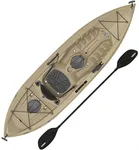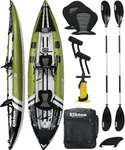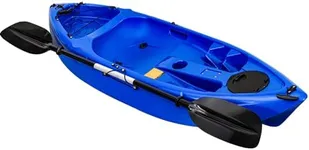Buying Guide for the Best Sit On Top Kayaks
Choosing the right sit-on-top kayak can greatly enhance your paddling experience, whether you're a beginner or an experienced kayaker. Sit-on-top kayaks are popular for their stability, ease of use, and versatility. They are great for recreational paddling, fishing, and even some light touring. To find the best fit for you, it's important to consider several key specifications that will affect your comfort, performance, and overall enjoyment on the water.LengthThe length of a kayak affects its speed, tracking, and maneuverability. Longer kayaks (12 feet and above) tend to be faster and track better, making them suitable for covering longer distances and open water. Shorter kayaks (under 12 feet) are more maneuverable and easier to handle, which is ideal for beginners, children, or those paddling in narrow or winding waterways. Consider your intended use: if you plan on long trips or open water paddling, a longer kayak may be better. For casual paddling or tight spaces, a shorter kayak is more appropriate.
WidthThe width of a kayak influences its stability and speed. Wider kayaks (over 30 inches) offer more stability, making them great for beginners, fishing, or activities where you need to move around or stand up. Narrower kayaks (under 30 inches) are generally faster and more efficient to paddle, which is beneficial for experienced paddlers or those looking to cover more distance. Think about your balance and comfort level: if stability is a priority, go for a wider kayak. If you want more speed and efficiency, a narrower kayak is the way to go.
Weight CapacityWeight capacity refers to the maximum weight a kayak can safely carry, including the paddler and any gear. It's important to choose a kayak with a weight capacity that exceeds your body weight plus the weight of your gear. Kayaks with higher weight capacities (over 300 pounds) are suitable for larger paddlers or those who plan to carry a lot of gear, such as for fishing or camping. Lower weight capacities (under 300 pounds) are sufficient for smaller paddlers or those who travel light. Ensure you have a comfortable margin to avoid overloading the kayak.
MaterialKayaks are made from various materials, each with its own advantages. Polyethylene plastic is durable and affordable, making it a popular choice for recreational kayaks. Composite materials like fiberglass or carbon fiber are lighter and offer better performance but are more expensive and less durable. Inflatable kayaks, made from PVC or similar materials, are portable and easy to store but may not perform as well as rigid kayaks. Consider how you will use and store your kayak: if you need durability and affordability, go for polyethylene. For better performance and lighter weight, consider composite materials. If storage space is an issue, an inflatable kayak might be the best option.
Seat ComfortThe comfort of the seat is crucial for enjoying your time on the water, especially on longer trips. Look for kayaks with adjustable, padded seats that provide good back support. Some kayaks offer high-back seats or even lawn-chair style seats for extra comfort. If you plan to spend several hours paddling, investing in a kayak with a comfortable seat can make a big difference. Test the seat if possible, or read reviews to ensure it meets your comfort needs.
Storage OptionsStorage options on a kayak include hatches, bungee cords, and tank wells. These features allow you to carry gear, food, and other essentials. If you plan on fishing, camping, or long trips, look for kayaks with ample storage space, including dry storage hatches to keep your belongings safe from water. For casual paddling, minimal storage may be sufficient. Consider what you need to bring with you and choose a kayak that offers the appropriate storage solutions.
StabilityStability is a key factor, especially for beginners or those using the kayak for activities like fishing. Primary stability refers to how stable the kayak feels when you first get in, while secondary stability refers to how stable it feels when you lean or edge the kayak. Wider kayaks generally offer better primary stability, making them feel more stable and less likely to tip over. If you are new to kayaking or plan to fish or stand up in your kayak, prioritize stability. More experienced paddlers might prefer a kayak with better secondary stability for more dynamic paddling.



















